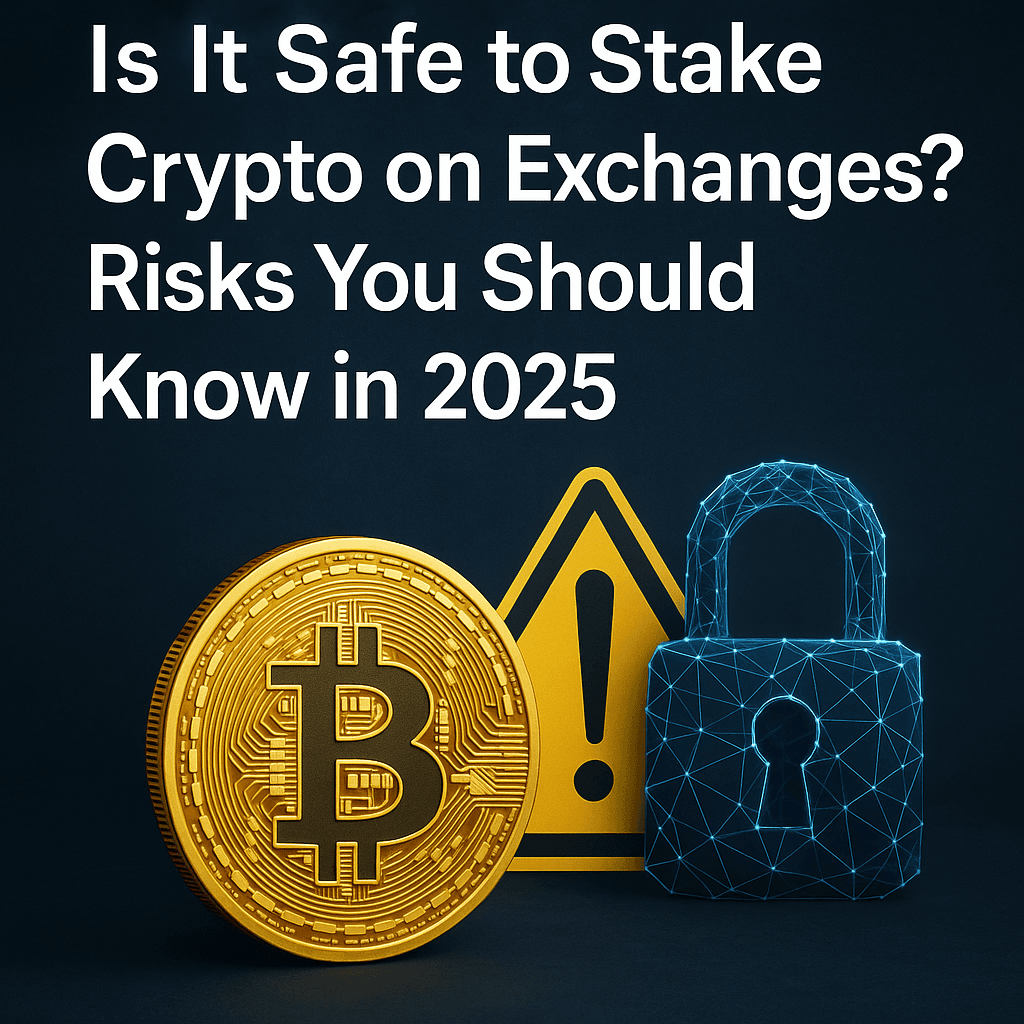Is It Safe to Stake Crypto on Exchanges? Risks You Should Know in 2025
By expert

Staking has become one of the most popular passive income strategies in the world of crypto. With centralized exchanges like Binance, Coinbase, and Kraken offering staking services, the barrier to entry has lowered significantly. But convenience comes with trade-offs. So in 2025, the question remains more relevant than ever: Is it safe to stake crypto on exchanges?
This article explores that very question, diving deep into the risks, how to mitigate them, and how staking on exchanges compares with other options in the current crypto landscape.
What is Crypto Staking on Exchanges?
Staking is the process of locking your crypto assets in a blockchain network to support operations like validating transactions. In return, you earn staking rewards—often paid out in the same cryptocurrency.
Centralized exchanges (CEXs) simplify the process by offering staking-as-a-service. Instead of running your own validator node, you can stake directly through your exchange account. You simply deposit your tokens into a staking pool managed by the exchange.
This ease of access has made staking increasingly popular—but has also introduced a new set of risks that users must consider.
🔗 Related: How Much Can You Earn Staking Crypto on Exchanges?
Is It Safe to Stake Crypto on Exchanges?
Staking on exchanges is convenient, especially for beginners. However, the safety of your assets depends on various factors like the exchange’s reputation, the specific staking terms, and the regulatory environment.
Let’s unpack the primary risks involved:
1. Custodial Risk
When you stake crypto on an exchange, you give up control over your private keys. In essence, the exchange becomes the custodian of your assets.
If the exchange faces internal mismanagement, bankruptcy, or a regulatory clampdown, your funds may be frozen or lost. Events like the collapse of FTX in 2022 serve as stark reminders of what can go wrong.
Not Your Keys, Not Your Coins — a saying that holds particularly true in staking.
2. Exchange Hacks & Security Vulnerabilities
Despite advances in cybersecurity, centralized exchanges remain lucrative targets for hackers. Over the years, platforms like Mt. Gox and Coincheck have lost billions in user funds due to security breaches.
Even if your exchange offers insurance, it might not cover staking losses or may be limited in scope.
3. Slashing and Validator Risks
Slashing is a penalty imposed on validators for malicious behavior or network failures. While staking through an exchange shields you from direct validator responsibilities, the risks aren’t entirely eliminated.
Some exchanges pass on slashing penalties to users. It’s critical to read the terms of service and understand how the exchange manages its validator nodes.
4. Lock-Up Periods and Liquidity Constraints
Most staking programs involve a lock-up period, during which your assets are inaccessible. If market conditions shift or you need funds urgently, you may be unable to act.
Some platforms offer liquid staking derivatives, but they come with their own sets of trade-offs and smart contract risks.
5. Regulatory Risks
With governments around the world tightening crypto regulations, staking is coming under increased scrutiny. Some jurisdictions may restrict staking services or impose new tax obligations.
In 2025, these uncertainties still pose real challenges. A sudden regulatory change can impact your ability to withdraw or earn from your staked assets.
6. Platform-Specific Terms
Each exchange has its own staking mechanics, fees, payout frequencies, and redemption timelines. These small details can significantly affect your profitability and flexibility.
Always review:
- Minimum staking amounts
- Reward distribution methods
- Early un-staking penalties
- Supported assets and networks
🔗 Related: Best Crypto APY Rates 2025 on Kraken: How Much Can You Earn Staking ETH, DOT, and More?
7. Transparency & Oversight
Many exchanges lack transparency regarding which validators they use or how staking rewards are distributed. Without on-chain proof or third-party auditing, you must rely on the platform’s integrity.
This creates a trust gap—especially when dealing with smaller or less-known exchanges.
How to Minimize Risk When Staking on Exchanges
If you still want to stake on exchanges—and for many users, it’s the most practical choice—here’s how to stay safe:
- Stick to Top-Tier Platforms: Use reputable, regulated exchanges like Coinbase, Kraken, or Binance.
- Diversify: Don’t stake all your assets in one place. Spread risk across exchanges or consider non-custodial wallets.
- Monitor APY & Lock-Up Terms: Use tools like our Crypto Staking Calculator to estimate returns and compare platforms.
- Use Liquid Staking Cautiously: Consider options like Lido or Rocket Pool, but be aware of smart contract vulnerabilities.
- Follow Regulatory Updates: Stay informed about laws affecting staking in your country.
FAQs: Staking Crypto on Exchanges
Q1: Can I lose money staking crypto on exchanges?
Yes. If the exchange is hacked, goes bankrupt, or faces penalties, your staked assets could be lost or devalued.
Q2: Is it better to stake using a hardware wallet or DeFi protocol?
Non-custodial methods offer more control but require greater technical knowledge. DeFi platforms also have smart contract risks.
Q3: What are staking rewards like in 2025?
They vary by asset and platform. Popular coins like ETH, DOT, and SOL offer 4–15% APY on major exchanges.
Q4: Can I access my funds anytime while staking?
Not always. Many platforms enforce a lock-up period or redemption delay. Review the terms before staking.
Final Thoughts: Is It Worth It?
So, is it safe to stake crypto on exchanges in 2025? The answer isn’t black or white. For many users, staking on CEXs is an easy way to earn passive income—but it does come with risks.
Your best strategy is to be informed, stay diversified, and avoid putting more into staking than you can afford to lock up.
By using tools like our Live Staking APY Rates and Staking Calculator, you can make smarter decisions that align with your financial goals.
📌 Bookmark our Crypto Staking Archives for weekly updates, APY changes, and platform reviews.
CryptoTrendd is your go-to resource for staying ahead in staking. Whether you’re a beginner or experienced investor, understanding the risks helps you stake smarter—not harder.
💬 What’s your experience with staking crypto on exchanges? Have you faced any issues or do you prefer non-custodial options? Share your thoughts below!
